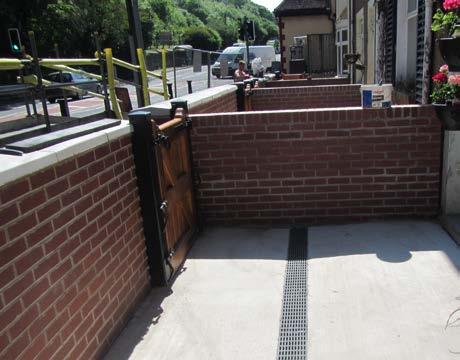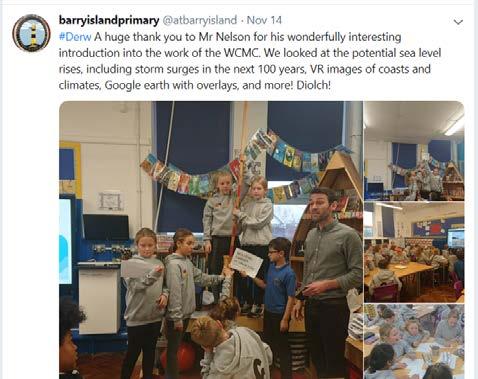
8 minute read
Objective B: Preparedness and Building Resilience
187. Wales Costal Group Forum will work with Coastal Groups to standardise a reporting method, by introducing criteria to emphasise progress on actions. This will support Measure 10 of this Strategy. 188. In addressing coastal flooding and implementing actions in the SMPs, Local Authorities may wish to speak to the
WCMC and NRW, who prepare and maintain technical guidance on coastal standards of service against flooding.
NRW continue to model risk from the sea, and are conducting research to improve understanding of joint probability and develop best practice guidance. 189. Flooding can span country boundaries so RMAs that border England must co-operate with the Environment
Agency and other English RMAs to make improve flood risk management and consider partnership funding. 190. The Environment Agency is working with English coastal groups to improve access and use of SMPs through the development of a web-based tool. The Welsh Government will extend this to include the four Welsh SMPs. NRW and Coastal Group Forum will liaise with the Environment
Agency on this extension.
Action Plans arising from the SMPs set out measures relevant to each stakeholder, and are for Coastal Groups to monitor and progress.
MEASURE 10: Coastal Groups to report annual progress on SMP Action Plans to the Welsh Government through the Wales Coastal Group Forum.
MEASURE 11: Coastal Groups to report on the implementation of SMP2 epoch 1 policies, through Wales Coastal Group Forum to the Welsh Government, by 2025.
Objectives supported: A-D
Coastal monitoring 191. Wales’ coastline is a dynamic environment. Man-made alterations to the coastline such as coastal defences impact on natural systems, particularly where controls have been put in place altering the way sediment moves along the coast. We need to improve our understanding of the long term trends and changing nature of those coastlines in order to manage the risks of flooding and erosion 192. We want RMAs to work together through the WCMC, collecting data to common standards and sharing expertise so that a long term repository of information can be built up over time supporting our strategy of prioritising investment. Objective B: Preparedness and Building Resilience
Community resilience and behaviours 193. The resilience of a community to flooding is a measure of how it responds to and recovers from a flood event. A resilient community is well prepared for a flood and knows what action to take to reduce the potential impacts and damage caused. It is also able to minimise the disruption caused and recovers quickly from flood events. RMAs, the emergency services and voluntary organisations all have a role to play in improving community resilience. 194. We also talk about environmental resilience and the ability for ecosystems to adapt and recover from flooding.
Whilst the personal and economic aspects of resilience are covered here, there is more on the resilience of catchments under the Natural Flood Management section (paragraphs 201-213). 195. The immediate response of a community to a flood can be improved greatly if they are prepared for the event, aware of the risks, and understand what practical actions they can take and who is most appropriate to help them at the time they need it most. 196. Under the Civil Contingencies Act 2004, all Category 1 and 2 responders44 have a duty to warn and inform the public if a flood emergency is likely to occur. 197. Under the Water Resources Act 1991, NRW provides a flood warning service to the public for river and coastal flooding. NRW have established agreements under the Civil
Contingencies Act 2004 with certain telecom providers to pre-register customers who live in flood warning areas onto its warning service. The public can also sign up for free flood warnings online via NRW’s website45 or by calling Floodline46 . 198. Understanding forecasts, assessing flood risk and communicating it is a key part of being prepared.
Working in partnership with the Met Office and Flood
Forecasting Centre, NRW assess risk from river, coastal and surface water and publish a 5 day flood forecast on its website. The Flood Forecasting Centre issue a Flood
Guidance Statement to Category 1 & 2 Responders in Wales. 199. There can be physical and psychological impacts from a flood event. We therefore support action to improve the resilience of communities so they are prepared to respond more effectively and recover quicker. This may include receiving flood warnings, the preparation of community flood plans and outreach work with residents, businesses and schools. 200.We want to encourage RMAs to have conversations with communities around their own management of risk and help them to become more resilient to the impacts of flooding. Closer collaboration between NRW and Local
Authorities to develop and engage with communities should become common practice.
201. Some elements of flood and coastal risk management are best handled by an individual household or business, for example, ensuring they are adequately insured, knowing what to do when flooding is expected and implementing resilience measures so they can recover quickly with less disruption to everyday life or their business. 202.Such behavioural change and work around accepting and managing risk requires support and information that is easily accessible. NRW have information on what to before, during and after a flood which will be enhanced as part of their online flood support improvements (see measure 11) including the new flood maps. 203.It remains the responsibility of a home or business owner to have adequate insurance cover against flooding. Affordability of home insurance has been significantly improved in Wales through the take up of a UK
Government initiative called Flood Re, introduced in 2016 under the Water Act (2014). 204.As well as making more affordable home insurance available to those at flood risk, part of Flood Re’s remit is to provide information to consumers about how to increase their understanding on flood risk and how they can take action to reduce that risk i.e. become better prepared. Further information can be found on the Flood
Re website47 . 205.Flood Re only applies to homes built before 2009 to help deter new development being located in flood prone areas. The Welsh Government supports this principle and directs new homes away from areas identified as medium or high risk through planning policy and TAN 15. 206.Property Flood Resilience measures can help to prevent flood water ingress into a building or aid rapid recovery following a flood event. This can reduce repair costs and the misery and disruption caused by flooding. These measures can be installed as either a preparatory measure for properties at risk of flooding, or retrofitted during the repair of buildings after they have been flooded. RMAs may also consider such interventions where NFM or traditional defences are difficult to implement or justify, however it remains the responsibility of the homeowner or business to take action to protect their property and belongings during a flood. 207. We have supported the work undertaken by the
Construction Industry Research and Information
Association, CIRIA, following consideration of a recommendation within the Bonfield Review48 to prepare a code of practice to standardise the UK provision of property flood resilience. The guidance49 was published in
February 2020.
Property Flood Resilience
Following the 2018 flooding of 5 properties in Penarth, the Vale of Glamorgan Council installed a new boundary wall incorporating floodgates which continues to protect the community.
Awareness Raising 208.A 2013 report into the need for Flood Support Service for
Wales50 identifies a series of tasks to improve support to communities before, during and after a flood. All RMAs have a part to play in this support and through their awareness-raising activities. 209.The Flood Awareness Wales programme, run by NRW and fully funded by the Welsh Government, helps communities understand their flood risk and practical steps they can take to manage the risk. 210. Flood Awareness Wales helps volunteers from communities to develop and maintain their own Community
Flood Plans. Flood plans capture information a community will need in the event of a flood, including the actions need to prepare, respond and recover, also referred to as ‘before, during and after’ a flood. Flood Awareness
Wales has helped over 1000 communities, schools and businesses across Wales develop flood plans and has been commended through an independent review51 .
Wales Coastal Monitoring Centre outreach work with schools


211. NRW are considering bringing the Flood Awareness Wales programme of work within its normal NRW flood awareness activities and digital improvements to improve access to information. The Welsh Government want to see this work continue, complemented by ongoing improvements to online flood information and social media activity. 212. Local Authorities also play a role in raising awareness of flood risk in communities. The Welsh Government understands that Local Authorities find this objective challenging, given the varying levels of resource available, and can seek advice and assistance from NRW. A recent report by WLGA52 on the options for management of flood and coastal erosion on a regional basis proposes such an approach to delivering flood awareness. 213. The preparation, design and construction of an alleviation scheme can be an excellent opportunity to raise awareness and involve residents, schools, landowners and local businesses in decisions which will affect their community.
This can be especially effective when planning catchment scale schemes, explaining NFM and introducing engineering and FCERM to young people. Such outreach work is grant eligible and should be included in business cases.
WCMC has worked with local schoolchildren and linked up with schools in American Samoa, Fiji and Australia, developing a series of lessons on climate change and coastal monitoring for year 6 pupils. This has been developed in line with the new school curriculum (2022) and lessons will be freely available to download for other schools to use. This is an example of how flood projects can embed the principles of 5 ways of working, as set-out in the Well-Being of Future Generations Act, and bring people from around the world facing similar challenges together.




